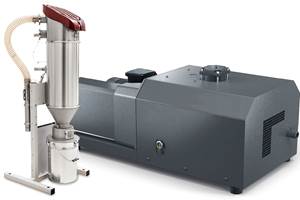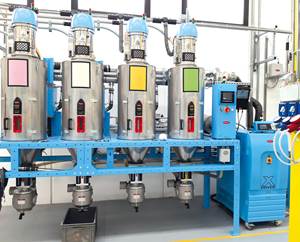Conveying Control Offers Auto-Configuration, Cost-Saving Diagnostics
New features said to simplify and reduce costs for system design and installation, system expansion, and remote diagnostics
The SmartFLX conveying control from Conair has been enhanced with a new system architecture with a more powerful PLC processor, faster and clearer communications, a Universal I/O panel structure, and an intelligent configurator that simplifies and reduces costs for system design and installation, system expansion, and remote diagnostics. By leveraging these improvements, Conair says many users will be able to adopt the SmartFLX system at a lower capital cost and with lower long-term operating costs than current FLX-128 systems.
Originally introduced in 2009, the FLX conveying control was developed as a “flexible” alternative to complex, large-scale control systems. Users could start small with a basic system of just eight loaders and two pumps (with one back-up pump), and retain the flexibility to increase capacity and capability over time. The original FLX system provides such high-level functions as multi-source/multi-destination loading, ratio loading, reverse common-line conveying for regrind recovery, fill sensing, and more. Over the years, the option to start small has remained, but the maximum capacity of the FLX system has expanded to the point that, when fully loaded, it can manage 40+ pumps, 128 receivers, and 256 controlled sources. In 2018, Conair offered users the option to add slow-speed, dense-phase Wave Conveying and Smart Services monitoring capabilities to the FLX system.
The new “smart” FLX conveying control system incorporates all of the FLX system capacity noted above, but does so with a new system architecture that is easier and more cost-effective to configure, install, manage, and expand,” says Nick Paradiso, Conair’s product manager, conveying systems.
A 10-in. high-resolution color monitor displays the new SmartFLX user interface, the product of extensive user testing, optimizes menu presentation and keystrokes associated with common user tasks. The interface incorporates a context-sensitive Help system that provides specific instructions for each screen presentation. It operates atop a new PLC processor and software, with all system intelligence centralized in the system’s main panel for easy, single-point software upgrades.

The new SmartFLX architecture separates communications into two channels. Control and diagnostic signaling for Conair equipment travels on a channel built to the lightning-fast, ultra low-noise Powerlink standard. This new standard, developed to support crystal-clear data communications in noisy industrial environments, operates at a speed that is more than 6000 times faster than older communications protocols. All third-party equipment, as well as system reporting functions, are carried on the second data communications channel, which operates using the versatile and proven Modbus communication protocol.
A key cost-saving feature of the SmartFLX architecture are “universal” system I/O panels. These enable any factory-configured SmartFLX system main panel (and remote or utility panel, when needed), to accept and operate any type of I/O — analog or digital, alarm or HMI, Wave Conveying valves or sensors, or pumps/receivers/loaders/ratio valves — in any available slots. This innovation means that the SmartFLX system can now support greater overall capacity – up to 40+ pumps, 256+ receivers and 500+ controlled sources and all available features—using just three I/O panel types. Operating the same features and equipment—many of which were added to the original FLX control following its introduction—would have required purchase and configuration of up to eight different, dedicated types of I/O panels.
Also unique to the SmartFLX system is a software-based system configurator that simplifies everything from system design and ordering, to installation and expansion, to operations and maintenance/troubleshooting. When provided with initial conveying system and equipment requirements, the configurator can automatically develop an optimized conveying system plan, delivered in a set of current, complete system configuration files. These revision-controlled files can then be used to generate a complete bill of materials, suitable for project ordering, plus detailed electrical schematics and “point to point” I/O maps to guide installation and wiring.
Should system growth be required, the SmartFLX configurator can automatically identify available panel and I/O capacity, assess whether this capacity will be sufficient to meet the additional need, then provide an optimized installation plan. When the installation plan is accepted, the configurator automatically updates all system configuration files so that every detail of the latest installation is preserved.
Related Content
Central Controller, Energy-Efficient Pump for Conveying
Wittmann debuts new control system and pump at Fakuma.
Read MoreFinding Efficiencies in How Components Work Together
Auxiliary systems are vital to the proper functioning of a plastic processing line, and they can be a source of major cost and efficiency improvements.
Read MoreConveyor Controller Ideal for Expanding Plants
Billed as the most flexible and reliable discrete wired conveying controller on the market.
Read MoreCut Loading Time Through Direct Charge Blending
Direct charge blender loading, a vacuum-powered automation process, can dramatically improve loading time and reduce material costs. In this article, we address ten common questions to help you determine if the systems are right for your facility.
Read MoreRead Next
Understanding Melting in Single-Screw Extruders
You can better visualize the melting process by “flipping” the observation point so that the barrel appears to be turning clockwise around a stationary screw.
Read MoreLead the Conversation, Change the Conversation
Coverage of single-use plastics can be both misleading and demoralizing. Here are 10 tips for changing the perception of the plastics industry at your company and in your community.
Read More









